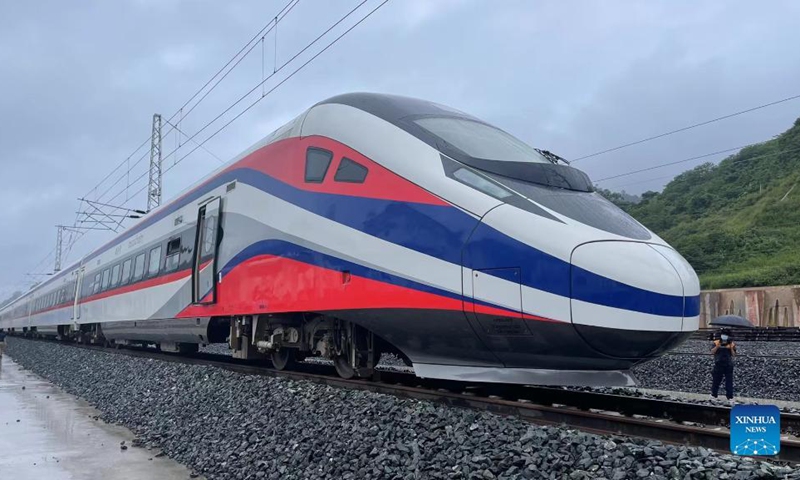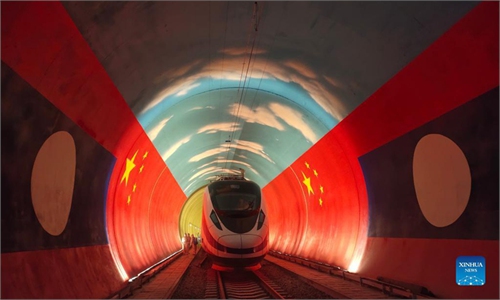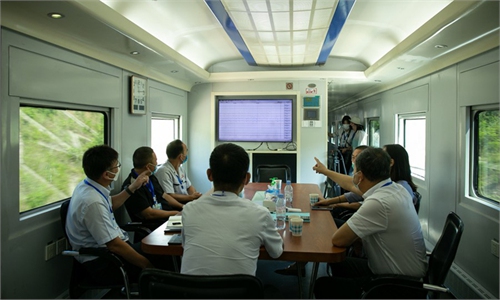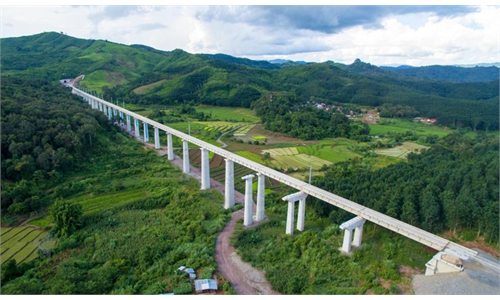
The Lane Xang EMU train arrives at the northern Laos' border town of Boten, after passing by the China-Laos borderline, Oct. 15, 2021. The streamlined "China-standard" bullet train, or electric multiple unit (EMU) train, for the China-Laos railway arrived at the newly built China-Laos Railway Vientiane Station on Saturday.(Photo: Xinhua)
China and Laos on Tuesday signed the first inter-governmental agreement on railway cooperation for the soon-to-launch 1,035-kilometer China-Laos railway, creating a framework for cross-border transportation, China's national railway authority said on Tuesday.
The agreement will serve as a legal framework for the cross-border movement of people and goods along the railway at the border, and it will ensure the smooth operation of the railway, which is to be launched later this week, according to a senior Chinese expert on Southeast Asian studies.
The agreement was signed virtually by the heads of China's National Railway Administration (NRA) and Laos' Ministry of Public Works and Transport, according to the NRA.
The construction of the railway, from Kunming in Southwest China's Yunnan Province to the capital of Laos, Vientiane, started in December 2016.
Xu Liping, director of the Center for Southeast Asian Studies at the Chinese Academy of Social Sciences in Beijing, told the Global Times on Tuesday that the agreement would mitigate inconsistencies in the ways that the railway operators of the two countries manage the line, and the agreement is of fundamental importance to the smooth operation of the railway.
Xu expected that the railway will mostly handle cargo in its initial stage of operation, given the COVID-19 pandemic situation that has greatly stalled international travel.
Analysts said the China-Laos Railway will establish a rapid transit and commercial link between Laos and the world's second-largest economy, powering Laos' economic growth and transforming the land-locked country into a land-linked hub with exporting and manufacturing capacities.
The electrified passenger and cargo railway will eventually be connected to railways in Thailand, Malaysia, and Singapore.
With a designated speed of 160 kilometers per hour, the travel time from Vientiane to the China-Laos border will be shortened from two days to just three hours, and the journey to Kunming can be done overnight, according to the Xinhua News Agency.
As part of the Belt and Road Initiative (BRI), the railway connects Laos with "not only China, but also the entire BRI network," according to a World Bank report in 2020.
The railway will bring a significant reduction in transport costs, by some 30-50 percent depending on the method of calculation, and is expected to increase trade flows between China and Laos to 3.7 million tons by 2030, according to the World Bank.
Trade passing through Laos along the railway corridor could reach an estimated 3.9 million tons per year by 2030.




